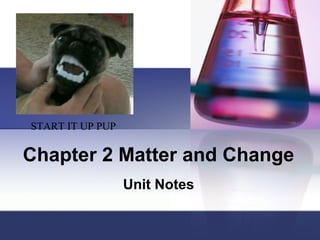
Chapter 2 matter and change
- 1. Chapter 2 Matter and Change Unit Notes START IT UP PUP
- 2. Section 2.1 Properties of Matter What is matter?
- 3. Which of these is matter? air water smoke light heat cold darkness jello sound human cloud diamond
- 4. What is matter? Matter is anything that has mass and takes up space. Matter can be classified by extensive or intensive properties.
- 5. What Is Matter? Extensive depends on the amount of matter in the sample. Intensive does not depend on the amount but the type of matter in the sample.
- 6. Intensive Color Odor Luster - How shiny a substance is. Malleability - The ability of a substance to be beaten into thin sheets. Ductility - The ability of a substance to be drawn into thin wires.
- 7. Intensive Conductivity - The ability of a substance to allow the flow of energy or electricity. Hardness - How easily a substance can be scratched. Melting/Freezing Point - The temperature at which the solid and liquid phases of a substance are in equilibrium at atmospheric pressure. Boiling Point - The temperature at which the vapor pressure of a liquid is equal to the pressure on the liquid (generally atmospheric pressure). Density
- 8. Extensive Mass - A measurement of the amount of matter in a object (grams). Weight - A measurement of the gravitational force of attraction of the earth acting on an object. Volume - A measurement of the amount of space a substance occupies. Length
- 9. What is a substance? Matter that has a uniform and definite composition is called a substance. Examples are: gold, copper, iron, water, sodium chloride (salt), oxygen (see table 2.1) Physical properties can be used to identify unknown substances.
- 10. States of Matter The three main states of matter are: solid, liquid and gas.
- 11. Solids Solids have a definite shape and volume. The shape of the solid doesn’t depend on the shape of the container. Solids are incompressible. Expand slightly when heated. Particle vibrate in place.
- 12. Liquids Indefinite shape Definite volume Not easily compressed Expand slightly when heated. Particles can flow.
- 13. Gases Indefinite shape. Indefinite volume. Easily compressed. Particles are free to roam everywhere.
- 14. Vocabulary Cards Matter Extensive (give examples) Intensive (give examples) Substance
- 15. Mixtures 2.2 Mixtures are classified into two groups. Mixtures are physical blends of two or more components. Heterogeneous mixtures are not uniform. Their components are not evenly distributed.
- 16. Mixtures Homogeneous mixtures are uniform and their components are evenly distributed. Phases describe any part of a mixture that has uniform composition and properties.
- 17. What kind of mixture is it? heterogeneous Homogeneous heterogeneousHomogeneous Homogeneous
- 18. Elements and compounds 2.3 Compounds can be broken down into simpler substances by chemical means. Elements cannot. If the composition of a material is fixed, the material is a substance.
- 19. Elements and Compounds If the composition of a material can vary, it is a mixture. Chemical symbols are used to represent elements on the periodic table.
- 20. Chemical Reactions 2.4 During a chemical change, the composition of matter always changes. A substance present at the start of the reaction is called the reactant. The substance present at the end of the reaction is called the product.
- 21. Chemical Reactions Clues that a chemical change has occurred are: energy transfer (hot or cold feeling), change in color, gas production, formation of a precipitate (solid stuff) During any chemical reaction, the mass of the reactants and the products must equal each other. Its called the Law of Conservation of Mass.
- 22. How can you recognize a physical versus and chemical change? Breaking glass Frying an egg Shaking pop Ice pack Burning a match Freezing water Hand warmers Cooking macaroni Rusting car Boiling water Chopping veggies Baking a cake
- 23. Vocabulary Cards Mixture Heterogeneous Homogeneous Compound Element Reactant product
- 24. LET’S REVIEW SO WE DON’T HIT A WALL WHEN WE TAKE THE TEST
- 25. Substance Matter that has the same composition and properties throughout is called a substance.
- 26. Compound A compound is a substance whose smallest unit is made up of atoms of more than one element chemically bonded together.
- 27. Mixture When two or more substances (element and compounds) come together but don’t combine to create a new substance, a mixture results.
- 28. Homogeneous Mixture These mixtures are the same throughout. You can’t see the different parts.
- 29. Heterogeneous Mixture These mixtures are not the same throughout and you can see the individual parts.
- 30. Which one is it? compound compound mixture mixture mixture compound
- 31. A chemical reaction must make something totally different that has different properties from when it started. You start with the reactants And you end with the products
- 32. When you make a sandwich, what do you do?
- 33. When you make a sandwich, what do you do? Reactants Products
- 35. SCIENCE SWAG EXTRA CREDIT: Create a video, poem story, song or rap about the states of matter. Poem or story must be one page. Video, song or rap must be 1 1/2 minutes. Make sure the projects include good facts about the states of matter. Due in one week.
